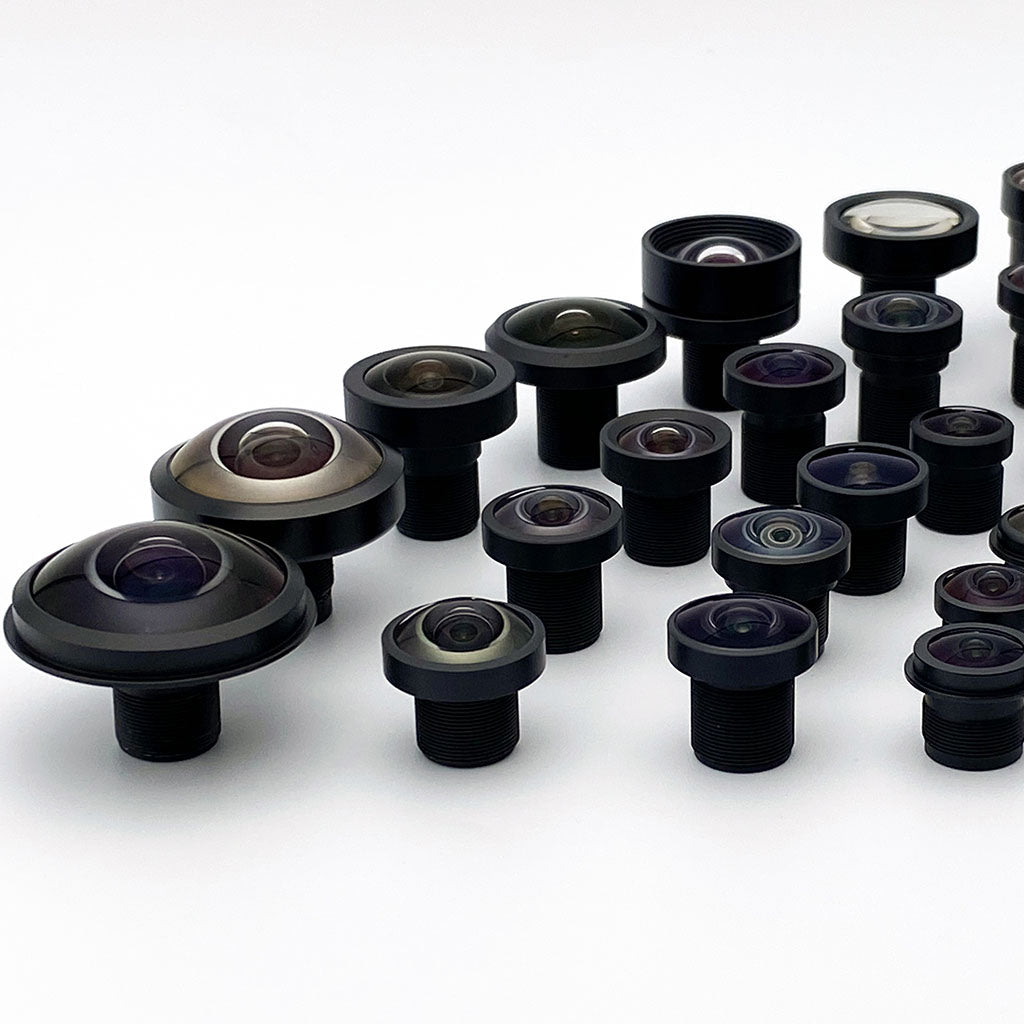Types of Camera Lens Mounts – C-Mount, CS-Mount, and M12 Mount (S-Mount)
Lens mounts are the mechanical interfaces that attach a lens to a camera and set the correct distance for focus.
Choosing the right mount is critical to ensure the lens can focus properly. Frequently asked first questions when building a camera is:
- Will my CS Mount Lens work with my C Camera Mount?
- Will my C Mount Lens work with my CS Camera Mount?
- What is the difference between a S Mount lens and a M12 lens?
- How can I use an M12 lens with a C / CS mount camera?
If you've wondered any of the above, you're in the right place! Below is a concise guide to lens mount compatibility. We’ll compare C-mount vs CS-mount lenses and M12 vs C/CS-mount lenses – highlighting key differences, compatibility issues, and use cases.

What is the difference between C and CS mount?
C-Mount vs CS-Mount Lenses
C-mount and CS-mount are both common screw-threaded lens mounts used in machine vision and CCTV cameras. They share the same thread size (1-inch diameter, 32 threads per inch), but the flange height (also known as focal distance FFD) is different. The flange focal distance is the distance from the mount’s shoulder to the camera’s image sensor plane.
We believe the "S" in CS-mount means "Short" which explains why:
- C-mount lenses have a standard flange height of 17.526mm.
- CS-mount lenses have a 5mm shorter FFD of 12.5mm. This improves optical performance and/or reduces optical design complexity and cost.
C-mount vs CS-mount compatibility is therefore one-way:
1.) A C-mount lens can only reach focus on a CS-mount camera if a 5mm spacer ring is added.
2.) CS-mount lenses CANNOT be used on C-mount cameras. Physically the lens will thread on, but because the CS lens is designed for a shorter distance, it will focus the image in front of the sensor on a C camera. There is no simple adapter to fix this – the lens just can’t be placed far enough forward to focus on the sensor.
M12 Lens Mount vs C-Mount vs CS-Mount Lenses
M12 lenses (also known as S-mount lenses) are miniature lenses with a 12 mm diameter thread (M12 x 0.5). They are widely used in compact board cameras.
Comparing an M12 lens vs a C-mount lens (or CS-mount) reveals major differences in size and standardization:
Physical Size and Thread:
M12 lenses are much smaller. They use a metric M12×0.5 thread instead of the 1″-32 UN thread of C/CS mounts. The entire lens is often only a few centimeters long. This compact size makes M12 lenses ideal for small embedded cameras, but it also means they typically work with smaller image sensors up to about 2/3″ sensor formats.
In contrast, C-mount lenses are larger and can support sensors up to around 1″ or more.
Flange Focal Distance:
Unlike C/CS, the M12 mount does not have a standardized flange focal distance. The distance from the lens to the sensor in M12 systems depends on the specific lens design and the lens holder used. Each M12 lens must be matched with a compatible lens mount holder and adjusted (typically by screwing in/out) to focus on the sensor.
Not all M12 lenses are interchangeable across different holders or cameras – you must ensure the mechanical back focal length and lens barrel length suit your camera’s mount. In other words, an M12 lens that works in one camera might not focus in another if the lens housing is different.
Mounting and Adaptability:
M12 lenses screw into small lens holders on the camera board (often secured with glue or screws once focused). These holders are sometimes called S-mount or board-mount holders. Adapters do exist to use an M12 lens on a C-mount or CS-mount camera. However, compatibility is not guaranteed. In practice, if you attach an M12 lens with an adapter to a C-mount camera, it may not be able to focus to infinity or it might vignette since M12 lenses are designed for smaller sensors.
Always check the lens specifications and, if possible, test the combination before committing to an M12-vs-C/CS swap. In short, M12 vs C-mount/CS-mount lenses trade off flexibility for size and cost.
A Machine Vision Camera and Lens Compatibility Table
Camera Mount Compatibility Table
Matching a lens type with mount type can be frustrating if you've purchased a lens and discovered that it cannot focus on your camera. If you are running into this problem, you're not alone! Check this lens mount compatibility chart to help you determine if you accidentally chose an incompatible lens for your camera.

For S-Mount or M12 Lenses, a mechanical comparison is needed between the lens, the lens mount, and the camera housing. The mechanical design for each M12 lens is different, as this mount type is not standardized.
The back focal length and diameters of M12 / S Mount lenses are frequently incompatible with CS and C Mount cameras, resulting in a lens-to-mount combination which cannot be focused. This incompatibility can also occur with other M12 lens mounts.
Versuchen Sie, Ihre Kameraanforderungen zu bestimmen?
Benutzen Sie unseren kostenlosen webbasierten AoV-Rechner, um die Anforderungen an das Sichtfeld Ihres Systems zu bestimmen. Verwenden Sie dann den M12-Objektiv-Rechner, um Ihre Anforderungen mit den verfügbaren Objektiven abzugleichen. Unser Schärfentiefe-Rechner liefert auch den hyperfokalen Abstand und die Schärfentiefe für jede Sensor- und Objektivkombination.
Wir haben auch eine Reihe anderer Rechner, die für viele Ingenieure interessant sind.









